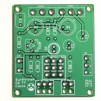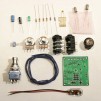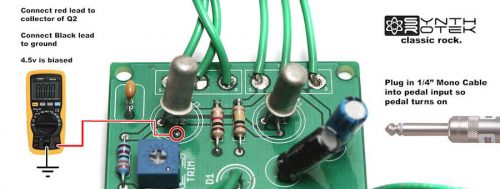Important Links
Product Page
Store Page
Assembly Instructions
Bill of Materials
Fuzz Face Drill Template
Schematic
Capacitor and Resistor Lookup Guide
 |
 |
This Arbiter Fuzz Face Clone is based on the classic Dallas Arbiter Fuzz and uses Silicon BC588 PNP Transistors and is powered from the negative rail (must use a different adapter from pedals that take 9V center negative power, ie. Boss and One Spot). We also have the Face the Fuzz, which CAN be used with standard CENTER NEGATIVE Boss or One Spot style adapter and CAN be daisy chained other like powered pedals. We also changed the output capacitor to pass more bass which gives a “fuller” tone.
Features:
- 3 controls – Fuzz, Level, and internal trim pot – for precise biasing and tone control. Fuzz sends your tone from subtle to razor blades and Level adjusts your output level for boosts. On-board trim pot lets you adjust your output transistor bias level for a variety of new Fuzz tones!
- 3PDT switch allows for true bypass switching and LED indicator gives you a visual cue when your circuit is engaged and using power
- Dual power supplies (9V Battery and +9VDC =>200mA Center Positive DC Power Supplies) allow you to have the battery as backup or as the main power
- Input jack switching – No instrument cable plugged in, no power used. Save life on your expensive batteries!
- PCBs are professionally manufactured and designed here at Synthrotek. PCB silkscreen, through-hole components with careful on-board placement, and wire-tension relief holes were designed with the DIYer in mind!
- PCB Dimensions: 2.0″ x 1.5″
Biasing Instructions:
For the Fuzz Face circuit to be optimally biased, the collector of Q2 needs to be at 4.5 volts. (When connecting the Arbiter Fuzz Face Clone circuit to your multimeter as shown in the photos below your meter will read -4.5v) The 20K trim pot is used to dial in this value. You will need a multi-meter that reads DC voltage to accomplish this, which can be found very inexpensively at places like Harbor Freight Tools. All you need to do is connect your leads to a ground on the PCB and the collector of Q2 to get this reading. (Pedal must be powered on)





Will this kit fit in a 1590B enclosure?
It CAN, but I would suggest a 1590BB, it is MUCH easier